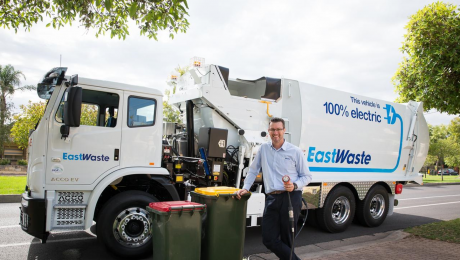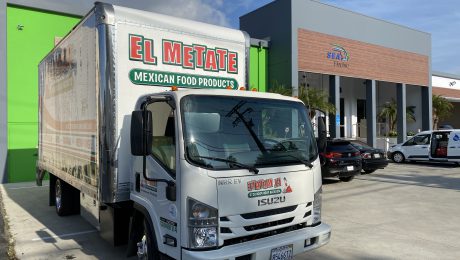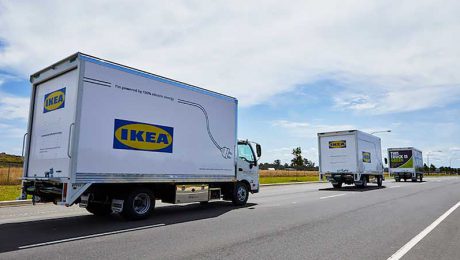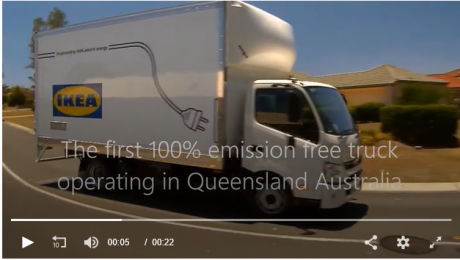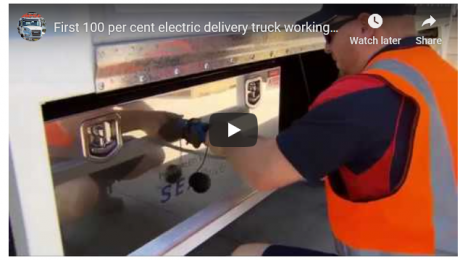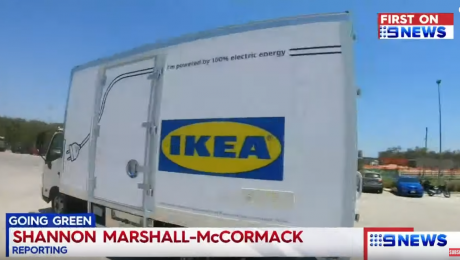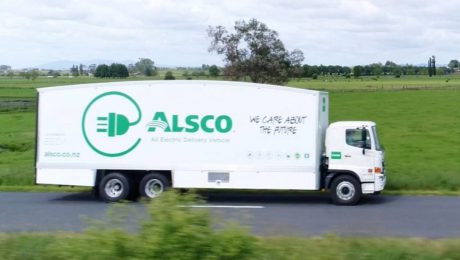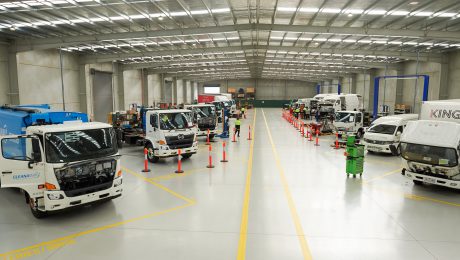Aussie SEA Electric granted patent for Commercial EV management system
SEA Electric make fully electric commercial vehicles and are quickly gaining international attention. While the sexy consumer battles of Tesla vs Porsche get plenty of headlines, the transition of commercial vehicles to electric powertrains is likely more difficult challenge and one Australians are not shying away from.
The Aussie company achieved another important milestone this week, with the successful granting of the patent for its SEA-Drive technology in Australia. The ‘Management System for Commercial Electric Vehicles’ patent was granted on the 28th of February 2020 after the initial submission on the 18th April 2017 (yep, our patent office works quickly).
The patent
The patent covers a management system for a commercial electric vehicle (EV), comprising:
- A controller area network (CAN) comprising a plurality of CAN buses connected to a plurality of components of the EV.
- A vehicle controller connected to the CAN and configured to monitor and/or control the plurality of components of the EV based on CAN signals.
Wherein the plurality of CAN buses and their respective components comprise:
- A drive CAN bus connected to a motor controller system comprising a motor controller connected to an electric motor.
- A battery CAN bus connected to a battery system comprising a high−voltage (HV) battery.
- A telematics CAN bus connected to a telematics system.
Wherein the vehicle controller is further configured to:
- Measure operating temperature of the motor controller and adjust the speed of a cooling pump and a radiator fan to maintain a predetermined operating temperature.
- Monitor a state of battery contactors of the HV battery and optimize an amount of time required to start the EV.

The milestone is the culmination of many years of research, product development and system optimization. This was reached after tens of thousands of miles of testing on SEA Electric’s generation 1 power-system technology, combined with the now patented generation 2 power-system, known as SEA-Drive.
The company now has more than a million miles of performance validation data to show it’s benefits of performance, cost and weight.
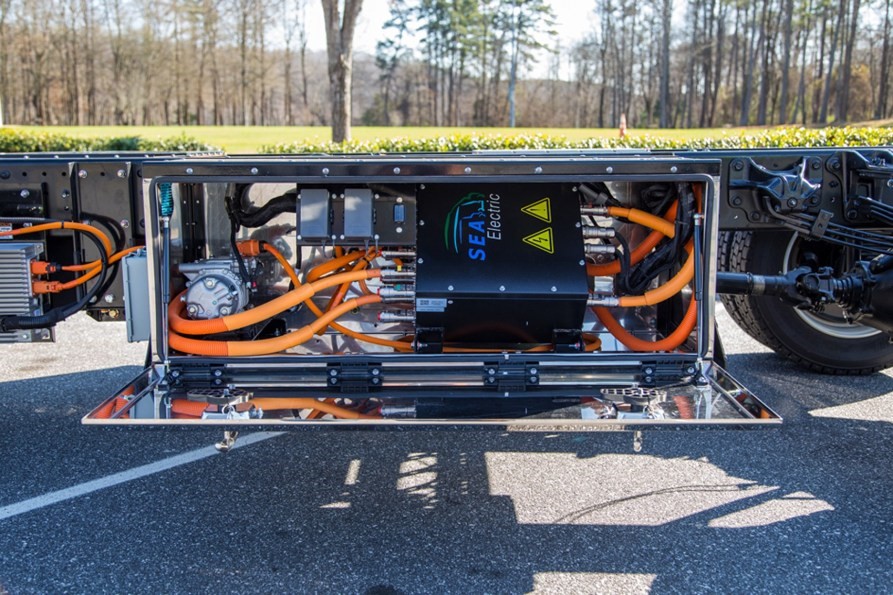
“Our overnight success has been almost a decade in the making and is a credit to the incredible team built by SEA Electric. Australian Universities have recognized the importance of this automotive segment and have invested in producing some of the best electric vehicle engineering talent in the world.
Our employees are practically, intellectually and emotionally invested in finding solutions to the real-world problems associated with hydrocarbon fueled commercial vehicles.”
SEA Electric’s Founder and President, Tony Fairweather reflects.
SEA Electric’s SEA-Drive technology is patent pending in another 15 countries/regions, and it is expected further approvals like Australia’s will come into effect throughout 2020.
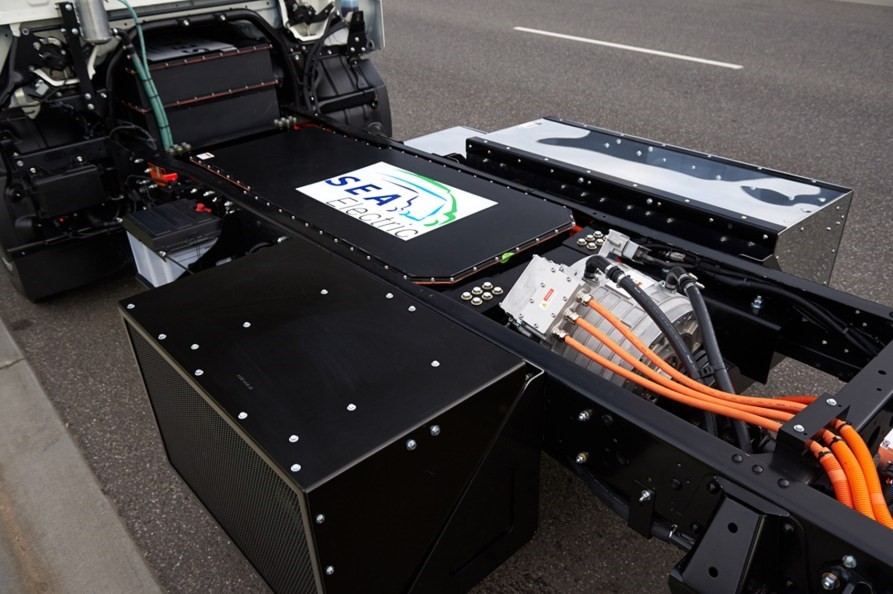
“With the granting of this patent, SEA Electric further enhances its reputation as a Commercial Electric Vehicle innovator and disruptor. The SEA-Drive technology is designed to exceed the unique performance requirements of commercial vehicles and it is a proven alternative power train to existing hydrocarbon fueled solutions.
SEA Electric is continuing to develop, enhance and deploy its electric SEA-Drive technology in collaboration with like-minded OEM’s across a range of van and truck-based platforms in all major global markets.” Glen Walker, Regional Director for SEA Electric’s Oceania Region. READ MORE
Techau, Posted by Jason Cartwright on March 2, 2020
- Published in Articles, E-Range, Media Release, News, SEA-Drive, Technology, Uncategorized
First electric-powered kerbside collection truck for SA
Picture: PLUGGED IN, East Waste GM Rob Gregory said the new Acco EV is much cheaper to run than a conventional truck in the long-term.
SOUTH Australia’s first electric-powered kerbside collection truck is now operating on the streets of metropolitan Adelaide.
East Waste General Manager Rob Gregory said the new truck replaces a diesel-powered truck and, with zero emissions, will remove from our suburban streets the equivalent of 20 vehicles generating 63 tonnes of carbon dioxide every year.
The truck is the first in a fleet replacement program and is supplied by an Australian company, Superior Pak, using drivetrain technology from another Australian company, SEA Electric.
It cost about $550,000, which is $150,000 more than a diesel truck. The extra investment will return financial savings along with a raft of environmental benefits.
“It is much more than a terrific environmental initiative by East Waste,” said Mr Gregory.
“It will deliver financial gain to better manage the cost of kerbside collections of recyclable resources and waste. We conservatively project that our new electric vehicle will save more than $220,000 over the seven-year life of its diesel predecessor. Even with the extra $150,000 purchase price, that is a $70,000 saving.”
The cost savings will be greater if, as expected, diesel prices continue to climb. Moreover, with significantly fewer moving parts than a conventional motor, the new truck is expected to last longer than seven years.
Maintenance costs will be reduced by at least two-thirds. The truck’s drivetrain generates electricity each time it reduces speed, returning charge to the batteries and reducing wear and tear; specially to brake pads.
“Residents will fall in love with our new truck without realising it,” said Mr Gregory.
“With reduced air pollution comes the removal of noise pollution as the truck travels from house to house on bin collection day. It is almost silent.”
East Waste installed a 36kw solar system at its Ottaway depot to provide renewable energy to charge the truck’s batteries every day.
East Waste is a subsidiary of seven metropolitan Adelaide councils; the cities of Burnside, Campbelltown, Mitcham, Norwood, Payneham & St Peters and Prospect, the Town of Walkerville and the Adelaide Hills Council.
24th Feb 2020 7:30 AM, Big Rigs
- Published in Articles, Media Release, News, SEA-Drive, Technology, Uncategorized
SEA Electric powers ahead in the United States
Australian automotive technology company SEA Electric continues to power ahead in the United States opening a new California based office and expanding their Senior Sales team.
The new 12,000 square foot facility in Torrance, Los Angeles will act as the commercial EV hub for the California area. On the back of accepting large multiple EV truck orders from customers on the West Coast in 2019, the new SEA facility will provide a state-of-the-art delivery and maintenance center.
SEA Electric’s founder and President Tony Fairweather said “we are excited to add this important Torrance facility to our ever-expanding global footprint. California is a progressive, early adopter of our technology. We are proud to return that support with this facility.”
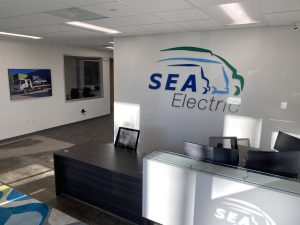
In another important step forward for the SEA Electric USA team Steve Brooks has been appointed as Vice President of Sales – North America.
Mr Brooks brings a wealth of trucking experience to the SEA Electric team with over 30 years’ in the medium/heavy duty trucking industry. As an accomplished professional Mr Brooks has been dedicated to supporting organizational excellence with a commitment to continuous product improvement, organisational development and customer success leading to spectacular outcomes in the fleet industry. Mr Brooks’ transformation leadership skills is a timely addition to a fast-growing SEA Electric USA division.
Mr Brooks has earned his undergraduate degree in Organizational Leadership from Arizona State University in Tempe, AZ, and a Master of Business Administration from the University of Redlands in Redlands, CA.

SEA Electric enjoyed tremendous growth in the United States in 2019 and would like to thank our valued customers for their support. Our 2019 successes and strong order bank provide a solid platform for expansion during 2020. New model releases, OEM partnerships, and many trade shows will ensure an exciting future. SEA Electric is also participating in CARB Certification in California and NYSERDA Certification in New York State, being the first commercial EV provider approved for Class 4 to Class 6 EV solutions on NYSERDA.
February 3, 2020
- Published in Articles, Media Release, News, SEA-Drive, Technology, Uncategorized
IKEA goes electric with zero emissions truck launched in Queensland
Swedish furniture retail giant Ikea’s Australian arm has added another clean and green electric delivery truck to its fleet, launched by transport service provider All Purpose Transport in Queensland.
The all-electric truck is another stepping stone towards Ikea Australia’s commitment to transition to a fully electric fleet by 2025 that it announced in March.
The commitment, which complements the home furnishings retailer’s leading role in switching to renewables including commercial-scale solar and clean energy bulk buys, will see Ikea transition its fleet of 100 large trucks and 250 smaller trucks to 10% all-electric by FY2020 and 100% by FY2025.
The new truck from Victoria-based electric automotive company SEA Electric which creates zero emissions heavy-duty vehicles from procured bodies and proprietary electric drivelines joins three others operated on behalf of Ikea in Sydney by ANC.
The electric delivery truck was launched to representatives of Ikea, All Purpose Transport and SEA Electric on Wednesday at an event that was attended by Queensland Minister for main roads and transport Mark Bailey.
Bailey congratulated the All Purpose Transport team via social media channel Twitter, saying that the move to go electric represented “great leadership in innovative clean energy technology“.
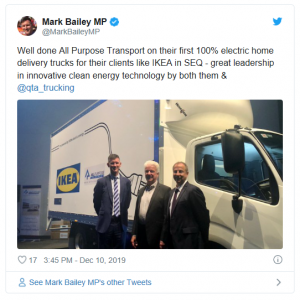
Parent group Inter Ikea has also committed €220 million ($A356 million) to transition to a “climate positive business” by taking measures such as investing in forest-based schemes to sequester carbon and sourcing energy from renewable sources in its supply chain.
Globally, Ikea’s greenhouse gas footprint is estimated at 26.9 million tonnes of CO2 equivalents year.
The Hino 917 truck, fitted a SEA-Drive® 120a system with up to 250kW power, 800Nm continuous torque and a 136kWh battery, will help reduce Ikea’s dependence on fossil fuels and its resultant carbon emissions.
“The 100% electric power-system offers a range of up to 300 kms (unladen), zero emissions saving an estimated 36 tonnes of CO2 per annum when compared to a typical diesel equivalent, enhanced driver comfort and safety with little heat and noise, and reduced cost of total ownership,” said Glen Walker, SEA Electric’s regional director of Oceania in a statement.
All Purpose Transport, which currently operates an owner-driver model, will evaluate the Hino 917 truck to establish the pros and cons for use as a delivery truck before considering an EV truck lease scheme for drivers, with a conservative plan to be 10% electric by the end of 2020.
“All Purpose Transport is a progressive transport business that wants to take a leadership role in Queensland towards reducing emissions with the introduction of Electric Vehicles,” said All Purpose Transport general manager Paul Kahlert said in a statement.
Speaking at the event, minister Bailey acknowledged that while Australia’s adoption of electric vehicles has been slow, the transition is now picking up pace.
SEA Electric CEO Tony Fairweather was encouraged by the minister’s speech saying that, “I am confident that this will be the start of many more electric commercial vehicles for Queensland.” READ MORE
Article by Bridie Schmidt, The Driven, December 12 2019

Bridie Schmidt is lead reporter for The Driven, sister site of Renew Economy. She specialises in writing about new technology, and has a keen interest in the role that zero-emissions transport has to play in sustainability.
- Published in Articles, Media Release, News, SEA-Drive, Technology, Uncategorized
Like minds at All Purpose and IKEA lead to EV move
SEA Electric’s modified Hino 917 glider a Queensland working first
A decade’s relationship between All Purpose Transport and homeware firm Ikea is behind the advent of Queensland’s first electric delivery truck entering service.
In hindsight, it is a likely outcome as delivery firm All Purpose has made a virtue of innovation, particularly in personnel development, while environmentally sensitive Ikea has already linked with fleet delivery service ANC in New South Wales for a commercial electric vehicle (CEV) effort there.
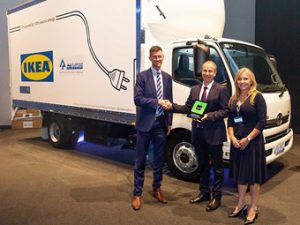
Mark Bailey, Paul Kahlert and Renea Robson at the official event
In both cases, the CEV in question is a modified Hino 917 glider with the SEA-Drive 120a power-system that was converted from diesel to electric, has a 200km-250km range, four-hour charging rate and a 3.5 tonne carrying capacity.
“We led the way with workforce development and now we are leading the way with last-mile emission-free deliveries,” All Purpose Transport GM Paul Kahlert.
“Our goal is to drive social change and focus on helping the environment. “We want to be leading the way in Queensland.”
The new electric vehicle would perform up to 15 deliveries a day whilst significantly reducing noise and carbon emissions to residential areas in Brisbane.
Ikea Australia spokesperson and store manager Renea Robson sees the truck’s launch of the truck as a significant milestone for the company as part of her firm’s EV strategy, which aims to have zero emissions for home deliveries by 2025.
“It’s a big commitment to move forward but we can’t do this if we’re not working with likeminded companies like All Purpose Transport who want to preserve the planet for future generations,” Robson says.
The sentiment chimes in with the views of Queensland transport and main roads minister Mark Bailey, who attended the official function at Brisbane’s Royal International Convention Centre.
“The country needed to see more of a shift towards clean energy in our economy as climate change is something impacting us and it’s great to see All Purpose Transport leading the way here,” Bailey says.
On that note, Kahlert tells Nine News organisations that “with the [economic] growth that we are seeing, it’s far better for the environment and far better for the residents as well.”
It was an important day for the Queensland Trucking Association (QTA), with CEO Gary Mahon supporting the move.
“They are a lot quieter vehicles, they are in urban environments – that’s a benefit as well,” Mahon tells the network. “Utilising electric vehicles may well drive down our costs.”
All Purpose Transport says it boasts more than 45 years’ experience and has completed over 20 million deliveries on behalf of leading retailers and manufacturers.
“All Purpose Transport partner with our customers and develop solutions that meet the ever-changing needs of our customers,” it adds.
“Our delivery heroes are often the only face to face interaction customers have throughout the delivery journey. “Our dedicated teams understand the value of all products we deliver and they are proud about the part they play in representing our customers.”
SEA Electric’s thumbs up
For SEA Electric, the outcome is the culmination of a three-year project with All Purpose.
“The 100 percent electric power-system offers a range of up to 300km (unladen), zero emissions saving an estimated 36 tonnes of CO2 per annum when compared to a typical diesel equivalent, enhanced driver comfort and safety with little heat and noise, and reduced total cost of ownership,” SEA Electric regional director of Oceania Glen Walker says.
The manufacturer notes the transport company operates an owner-driver model and they have purchased the SEA Hino 917 delivery truck to test the business benefits of running an electric delivery truck and evaluate the positives and negatives.
All Purpose Transport plans to offer an electric vehicle leasing scheme for a sustainable business model to their owner-drivers.
Of the ANC vehicles, SEA Electric reports have traveled 85,000km, traveling an average of 185km per day on a single charge, and made more than 5,000 deliveries with an average weight of around 2.5 tonnes.
“It is estimated in 10 months the three ANC electric trucks have saved a total of 90 tonnes of CO2,” it says.
SEA Electric founder and CEO Tony Fairweather says he is privileged to be invited to the All Purpose Transport launch of the first 100 percent electric delivery vehicle deployed in Queensland.
“The event was well represented by Ikea and many All Purpose Transport clients, as well as being supported by Queensland government with minister Mark Bailey addressing the room,” Fairweather says.
Fairweather adds he is encouraged by the content of Bailey’s speech, “with his acknowledgment of this fast transitioning segment and that Australia has been slow to adopt strategies to support it, however implying this would soon change.”
SEA Electric says that a further discussion after the minister’s address suggests that electric rubbish trucks should and will be supported in Queensland and was interested in the current status of our activity with Brisbane City Council.
“I am confident that this will be the start of many more electric commercial vehicles for Queensland,” Fairweather says. READ MORE
Article by Australasian Transport News (ATN), fullyloaded.com.au, 11th December 2019
- Published in Articles, Media Release, News, SEA-Drive, Technology, Uncategorized
Electric Truck Solution for Ikea
Queensland transport operator, All Purpose Transport, is now offering an electric truck solution for Ikea and its other customers, with the introduction of an electric delivery vehicle into the fleet.
The truck was launched in Brisbane at the Royal International Convention Centre by Queensland Minister for Transport and Main Roads, Mark Bailey.
“The country needs to see more of a shift towards clean energy in our economy as climate change is something impacting us and it’s great to see All Purpose Transport leading the way here,” said Bailey.
All Purpose Transport is a delivery solutions specialist in Queensland Australia, and has been committed to innovation and continuous improvement, with investment in technology, new services and training.
The truck is a modified Hino 917 with the SEA-Drive 120a power-system that was converted from diesel to electric, and it has a, claimed 200-250km range, four-hour charging rate and a three-and-a-half tonne carrying capacity.
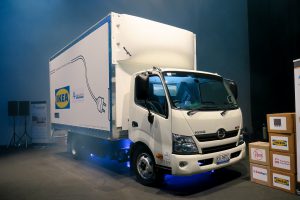
All Purpose Transport has been partnering with IKEA for 10 years and All Purpose Transport General Manager Paul Kahlert said the new electric vehicle would perform up to 15 deliveries a day whilst significantly reducing noise and carbon emissions to residential areas in Brisbane.
All Purpose Transport operates an owner driver model and they have purchased the SEA Hino 917 delivery truck to test the business benefits of running an electric delivery truck and evaluate the positives and negatives. All Purpose Transport plan to offer an electric vehicle leasing scheme as part of a sustainable business model for their owner drivers. The company is aiming for 10 per cent of their Ikea delivery fleet to be all-electric by the end of 2020.
“We led the way with workforce development and now we are leading the way with last mile emission free deliveries,” said Kahlert. “Our goal is to drive social change and focus on helping the environment. We want to be leading the way in Queensland.”
Ikea Australia’s Renea Robson said the launch of the truck was a significant milestone for the company, using the electric truck solution for Ikea as part of their electrical vehicle strategy, which is aiming to have zero emissions for home deliveries by 2025.
“It’s a big commitment to move forward but we can’t do this if we’re not working with like minded companies like All Purpose Transport who want to preserve the planet for future generations,” said Robson. READ MORE
Dieselnews.com.au, 11th December 2019
- Published in Articles, Media Release, News, SEA-Drive, Technology, Uncategorized
Electric trucks hit the road in Queensland | Nine News Australia
Channel 9 News Queensland report on Queensland’s first 100% electric truck.
Ikea is partnering with a logistics company to make Queensland’s first electric truck service.
WATCH VIDEO HERE: https://www.youtube.com/watch?v=7DjNcZXFU14
- Published in Articles, Media Release, News, SEA-Drive, Technology, Uncategorized
NZ’s first inter-city EV truck is on the road
Alsco New Zealand has launched what it claims is the country’s first “inter-city heavy EV” truck.
The company, formerly known as NZTS, serves about 30,000 customers per week cleaning and delivering uniforms/linen and distributing cleaning products.
Alsco is now running a Hino GH 1828 truck with a fully-EV power system producing a continuous 259kW (372kW maximum) and 1825Nm (3500Nm peak). The range to complete battery depletion is 200km.
Suff.co.nz – David Linklater 10:52, Nov 28 2019
Watch: Alsco explains how and why a heavy EV makes sense for New Zealand.
https://www.stuff.co.nz/motoring/EVs/117770655/nzs-first-intercity-ev-truck-is-on-the-road
- Published in Articles, Media Release, News, SEA-Drive, Technology, Uncategorized
Video: NZ’s first inter-city heavy EV road freighter launched
New Zealand’s first long-haul EV road freighter has been launched on November 27 at Auckland’s Eden Park by Alsco NZ.
The company, which provides linen, uniforms, floorcare, hygiene and first aid products, consumables and other rental services to more than 27,000 Kiwi businesses, will use the heavy EV for transporting such goods about 286km daily between Taupo, Rotorua and Tauranga.
Watch Video Here: http://evtalk.co.nz/video-nzs-first-inter-city-heavy-ev-road-freighter-launched/
Energy and resources minister Megan Woods, climate change minister James Shaw, Taupo mayor David Trewavas and other representatives attended the launch ceremony, along with Energy Efficiency and Conservation Authority (EECA) chief executive Andrew Caseley.
Alsco NZ received $50,126 towards the project in January from the low emission vehicles contestable fund administered by EECA.
“This will test the performance of EV technology in the freight sector,” Woods says.
The launch sent a message to the business community about the financial and environmental advantages of using a new class of EV transport.
“The transport industry and wider business will be most interested in the comparative capex and opex figures of a heavy EV compared to a diesel,” Alsco Group general manager Mark Roberts says.
“By adapting the build, and our operational model slightly, we are looking to demonstrate that the new EV technology is financially viable. That it is potentially a game-changer. It is an exciting step for Alsco, and for the heavy transport industry.”
Based on a Hino GH 1828 with an electric SEA-Drive 180 power system, the freighter weighs about 22.5 tonnes full, has 200km range, provides 372kW maximum power and 3500Nm torque, saves an estimated $49,740 in annual operational costs (no road user charge, halves maintenance and saves 25,000 litres of diesel and 67,610 kg of CO2 a year).
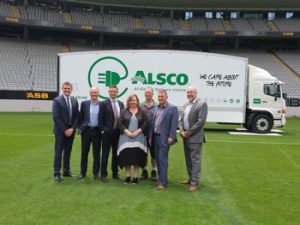
Alsco also advocates how wider business can better support regions by adopting cleaner and more financially viable transport options.
Converting a third of its fleet of 350, including 15 diesel freighters, to EVs and eliminating coal as an energy source are among four key sustainability goals Alsco NZ has through to 2030.
Shaw says the transition to a more climate constrained world will be one of the greatest drivers of innovation, the launch providing a classic example. READ MORE
EV Talk – Geoff Dobson November 27, 2019
- Published in Articles, Media Release, News, SEA-Drive, Technology, Uncategorized
SEA Electric wins 100-truck order in US
AUSTRALIAN electric vehicle start-up SEA Electric has scored its biggest order yet – 100 electrified Hino trucks for Californian electric vehicle service provider Zeem Solutions.
And the Melbourne-based company expects more such orders from California where government rebate vouchers can cut up to 80 per cent from the price of all-electric vehicles.
The single order from Zeem will almost double the production volume achieved to date by SEA Electric which has been operating for about three years, concentrating on electric vans and trucks.
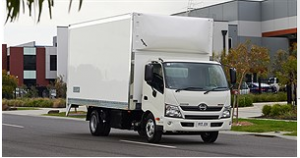
Cal tech: Melbourne-based SEA Electric has received an order for 100 electric-powered Hino 195s, similar to this SEA-powered Hino 917 EV destined for Ikea in Australia.
Californian company provides boost for Australian EV start-up SEA Electric
Based on an American-spec Hino 195 medium truck – nearly identical to the Hino 917 sold in Australia and elsewhere – the vehicles for Zeem will be fitted with the Australian-engineered powertrains in the US by a contractor, Fontaine Modifications, which has already started on the first vehicle.
Deliveries are scheduled to start in the first quarter of next year, with the remainder to be rolled out through 2020.
Australian engineers from SEA Electric have flown to California to oversee production of the initial vehicles which will be deployed by Zeem in Los Angeles and Sacramento where the company has service facilities.
Zeem will keep some of the trucks for itself, but most will go to lease customers for whom Zeem provides an EV consultancy service.
Zeem Solutions CEO Paul Gioupis said Zeem would keep spare vehicles to lessen downtime for customers during service.
“Once we have successfully deployed in Los Angeles and Sacramento, we will be rolling additional units out in San Francisco and San Diego,” he said.
The project has the blessing of Hino – Toyota’s commercial vehicle arm – which is supplying the base trucks for conversion.
In Australia, SEA Electric builds electrified Hino 917 trucks at its Dandenong South factory. So far, orders have included a delivery version for furniture giant Ikea and another truck set up as an elevated work platform for another customer.
SEA Electric also has a collaborations with Ford and with Isuzu in various markets.
The Ford project in Detroit centres on the F-59 workhorse that does a multitude of duties in the US, including postal delivery and school buses.
The Isuzu collaboration extends to South Africa where a SEA Electric-powered prototype is currently being developed.
SEA Electric also has projects in New Zealand and Thailand.
SEA Electric founder and president Tony Fairweather said his company was honoured to receive its first three-digit order from Zeem Solutions.
“Zeem Solutions are visionary in their approach to providing electric commercial vehicle offerings to their customers,” he said.
“The Hino 195 EVs will be deployed in California, a reflection on the excellent incentive program facilitated by CARB (California Air Resources Board) and Calstart (a national non-profit organisation promoting the eco-friendly vehicle industry).”
In Australia, no such incentives are on offer, making EV sales growth tougher.
The Hino 195 EVs for California get SEA Electric’s 128kW/1500Nm SEA-Drive 120a powertrain that, in this vehicle with a gross vehicle mass of more than 8.0 tonnes, should provide a driving range of about 320km.
The 120a powertrain is the third most powerful of the four SEA-Drive systems commercially available. The top-most 180a can deliver maximum power of 372kW and 3500Nm of torque – good for trucks of 18 tonnes and up.
Although SEA Electric has been operating from Dandenong South, it is planning to open a factory at Morwell in Victoria’s Latrobe Valley coal belt, with Victorian government support. READ MORE
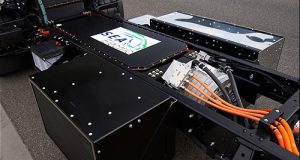
By RON HAMMERTON, Go Auto General News 20 Nov 2019
- Published in Articles, Media Release, News, SEA-Drive, Technology, Uncategorized
Australia’s SEA Electric is set to displace diesel in commercial vehicles worldwide
The Australia Institute’s National Energy Emissions Audit revealed the disheartening news that growth in diesel consumption, mainly in road transport, has negated gains made in carbon emissions reduction achieved in the NEM. But one Australian automotive-engineering firm has plans to transform the light-to-medium-duty diesel-slurping vehicle sector to run cleanly and quietly on electricity.

The City of Yarra is an early adopter of the SEA Electric-Isuzu medium-duty 100% electric tipper truck for rubbish collection. Image: SEA Electric
ShareIcon FacebookIcon TwitterIcon LinkedInIcon Google PlusIcon WhatsAppIcon Email
On Friday, Melbourne-based automotive technology company SEA Electric received its first three-figure order — 100 Hino 195s fitted to run on electric power — from US commercial electric vehicle (CEV) service provider Zeem Solutions.
The 100% electric medium-duty trucks will be assembled under license in the US by Fontaine Modifications which will upfit them with SEA-Drive 120a power systems. Designed in Australia, these motors deliver a range of up to 320 kilometres, 80 kW (110 horsepower) of continuous power, torque of 150 kg/m (1,500 Nm) and zero emissions.

US electric vehicle service provider, Zeem Solutions, has ordered 100 electric-powered Hino commercial vehicles under license from Australian SEA Electric. This chassis is the basis of the trucks soon to be quietly plying the streets of Los Angeles and Sacramento. Image: SEA Electric
Mechanical engineer Tony Fairweather, founder and President of SEA Electric, launched the company’s 100% electric power trains in 2017 after four years of product development and testing, at the moment when battery prices had reduced sufficiently to make electric drivetrains viable in the global market.
The company works with Hino, Isuzu, Iveco, Mercedes Benz and Dennis Eagle manufacturers to modify their commercial vehicles — rigid-chassis, two- and three-axle vans, medium-sized trucks and buses — to run on battery power.
“Battery technology has developed at an exponential rate in the past decade and prices have come down significantly, although they’re still in the range of US$250 per kilowatt hour,” Glen Walker, SEA Electric’s Regional Director for Oceania, tells pv magazine.
Radically reduced running costs
Whole-of-life operating costs make the premium paid for SEA Electric driven vehicles worthwhile on a purely economic basis, says Walker: “Even without [government] incentive, our vehicles cost less to own over the lifetime of those vehicles.”
With only one moving part — the electric motor itself — electric motors are far cheaper to run than petrol or diesel engines. “Maintenance, repairs and fuel are the three main things that have a dramatic impact on reducing that whole-of-life operating costs of our motors, to the point where the upfront purchase price premium is fully recovered in about four years; or every month if you’re on a monthly hire-purchase arrangement,” says Walker.
This year SEA Electric has made a string of announcements, including the availability of its SEA-Drive 100-powered Isuzu NPR 65-190 tipper truck; and the SEA-Drive 120b-powered Isuzu FTR-chassis elevated work platform (EWP) truck — a cherry picker with 2,500 Nm of torque, 150 kW continuous power and 250 kW maximum power.
New Zealand electricity distribution company WEL Networks was the first to purchase a SEA Electric EWP — with its motor capable of operating the elevated platform and travelling 200 km on a single charge — for use in line maintenance.
“We believe electric vehicles will play a really important part in New Zealand’s energy future,” said WEL Networks’ Chief Executive, Garth Dibley, who announced the vehicle’s deployment on 29 September. “By investing in electric trucks, we’re not only generating fewer emissions, but also helping to future proof our business and community.”
Diesel emissions run over GHG reductions in the NEM
The National Energy Emissions Audit (NEEA) for October 2019, released last month by The Australia Institute (TAI) brought home the relevance of diesel consumption in Australia. It showed that an increase in diesel combustion emissions of 21.7 Mt CO2-e — generated mainly by increases in diesel consumed by road transport and mining operations — over the period between the financial year 2011 to FY18 almost completely wipes out the decrease of 22.1 Mt CO2-e in emissions from electricity generation due to renewable generation entering the NEM over the same period.
NEEA author Hugh Saddler writes, “New and improved data shows that almost all the growth in diesel fuel is coming from increased retail sales of diesel, meaning diesel consumption by passenger and commercial vehicles.”

Road transport is a huge driver of growth in diesel consumption in Australia and resulting increasing GHG emissions. Graph: TAI
Although Australian governments have acted to improve the fuel efficiency of heavy road freight vehicles, little has been done to encourage efficiency in the light to medium-range of vehicles.
Missing electrifying incentive in Australia
SEA Electric’s Tony Fairweather notes that, “The Hino 195 EVs will be deployed in California, a reflection on the excellent incentive program facilitated by CARB and CALSTART.”
California Air Resource Board (CARB) Regulations were introduced in 2008, to reduce the greenhouse gas emissions of the estimated one million heavy-duty trucks that operate in California and have consistently been revised to drive greater reductions in road-transport emissions; while CALSTART is a not-for-profit organisation which provides services and consulting to accelerate advanced transportation technologies.
The development of the EWP first deployed by WEL Networks was a combined project of SEA Electric and CAL Isuzu in Hamilton, New Zealand, and was partly funded by New Zealand’s Energy Efficiency and Conservation Authority’s (EECA) Low Emission Vehicles Contestable Fund.
“The aim of the Fund is to drive innovation and grow confidence in an electrified vehicle fleet,” said Richard Briggs, Manager of Programme Partnerships at EECA. “Projects like this will show other heavy vehicle operators what’s possible and encourage them to invest in decarbonising their fleets.”
Solar PV leads the charge
WEL Networks already has a fleet of electric vehicles and more than 20 electric vehicle chargers in the Waikato region where it operates. Its new EWP takes between four and eight hours to fully recharge.

Pick of the cherry pickers runs 100% on electricity for WEL Networks in NZ. Image: SEA Electric
For any single SEA Electric CEV, Walker says charging by three-phase power at any fleet depot is completely viable, and the cost of running the vehicle is further reduced if the depot or business receives part or all of its energy from renewable sources — whether generated by onsite solar, solar and battery systems, or purchased via renewable power-purchase agreements or from utilities offering renewable-energy contracts.
Installation of high-speed DC chargers represents a significant capital outlay to businesses looking to adopt a fleet of commercial electric vehicles, but utilities and councils are among the likely first movers — with their operations paid for by their constituents and community pressure to decarbonise.
The City of Yarra council, for example, is running SEA’s first electric tipper truck, based on an Isuzu NPR 65-190 platform, for its hard rubbish collection.
In suburban environments, “not having exhaust emissions is a significant practical advantage of a CEV” Walker tells pv magazine.
As batteries reduce in cost, he says, the economics become ever more persuasive, “But as the expectation and the demand for cleaner and quieter urban environments increases, the rationale becomes quite different and there becomes an imperative to doing it. It’s not just a nice to have.”
The world is your noiseless oyster
Walker, who has worked in commercial transport for many years, says he was surprised, if not shocked, by the experience of first driving an SEA commercial electric vehicle. The power and responsiveness were indistinguishable from that of a diesel engine, but the silence in the absence of engine noise was deafening.
“You can hear the radio, you hear the wind rushing past the side-view mirror, but the main thing you hear is tyre noise — I thought, ‘Oh my goodness, tyres are loud!’”
He believes drivers of electric vehicles will experience less fatigue, because of both noise and fume reduction, than those who spend their days behind the wheel of fossil-fuel-powered engines.
In urban environments, where service or delivery vehicles would be hard-pressed to cover anywhere near 200 km in a day, the currently available battery density and efficiency already makes sense, as SEA Electric’s 130-plus vehicle sales (pre Zeem Solutions’ order) in Australia, New Zealand, the US and Thailand attest.
TAI’s Hugh Saddler writes that, “Much of the public debate about climate and energy policy fails to recognise the importance of emissions from use of petroleum fuels, especially diesel, to the extent that comments often seem to suggest that energy is synonymous with electricity.”
In fact the ability of growth in diesel use and emissions to all but eliminate gains from renewable energy’s reduction of carbon emissions from the electricity sector shows that “consumption of diesel should be receiving far more attention than it has done to date in discussions of how to reduce Australia’s greenhouse gas emissions”, Saddler says. READ MORE
PV Magaine Australia, November 18, 2019 by Natalie Filatoff
- Published in Articles, Media Release, News, SEA-Drive, Technology, Uncategorized


